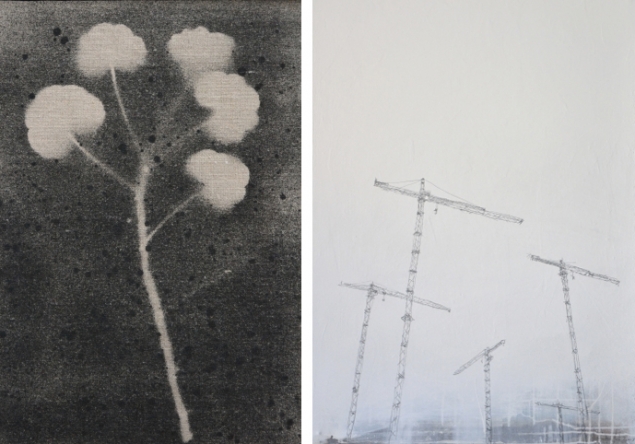Simon Job’s transient, minimalist works capture the natural forces that shift around us but lie just beyond our vision. Working through a variety of methods and mediums, this young emerging talent has cultivated a multi-faceted oeuvre of work that is minimal in stature yet high in impact. Organic, ephemeral and almost tangible, Simon’s artworks cross the boundaries of photography, painting, spray paint and collage. We visited the artist’s studio, chatting to the artist amidst stacks of his beautiful works to get the lowdown on how he fell into the world of art, what he loves most about his studio, and how he finds the balance between chaos and control.
When did you know you wanted to be an artist?
My mum is a painter, and when I was growing up she always encouraged me to draw and paint. I suppose it was a natural progression, although I wasn’t really aware of it - I didn’t know what I wanted to do until I ended up on an art and design course at college and realised that I loved it. Now I can’t imagine doing anything else.
Artwork: Trace: Colligere,
What was the first artwork you ever made? Can you remember?
Again, I was always creating from a young age but I think the first artwork that I considered to be a finished, serious, art piece probably came whilst I was at university. I remember being inspired by my tutors and gaining confidence in myself to create work that I was at ease with. I think this step in any artist’s development is key, allowing one to become self-aware and create work that is personal, considered and true to oneself.

Do you have a favourite or most meaningful piece?
My ‘Campbell's Variations’ series is one of my favourites since it represents a turning point in my way of thinking. I started to place more importance on the process that led to each finished piece. ‘Campbell's Variations’ are photograms captured directly from the light given by a computer screen from digital images of Warhol’s famous series. The photograms are then developed by hand. I love the idea that an original artwork could pass through so many formats, from the original to a photograph, to a digital image on the internet and then back again to an analogue reincarnation.
Left: Trace: Pelargonium,
Right: Citadel
Who are your favourite artists?
There are many painters I admire, from Twombly to Turner, but I also love the conceptual photographic work of artists such as Hiroshi Sugimoto and Myoung Ho Lee.
Tell me a bit about the process you used to create your work. What vision, ideas and/or inspirations are behind it?
The way in which I approach a piece of work varies massively depending on the ideas behind it, and the nature of the subject. I tend to use the method most appropriate to each specific concept, and this leads me to work in a range of mediums and styles. For example, photography might speak more clearly than a painting when articulating one idea, whilst painting might be the clear path for another. I try not to restrict myself.

When it comes to inspiration, this is also extremely varied. There are certain motifs that I have built up over the years that I frequently return to. These are heavy concepts including censorship, juxtaposition, simplification and ephemerality. I find that ideas normally spark whilst I’m immersed in the landscape, which is often the subject of my work.
What do you love most about art & making art? What do you hate most about it?
I love the freedom of it. You can create whatever you want and there are basically no rules. I love being my own boss and deciding how I want to go about something. The downside of being your own boss is that you have to do all the other less interesting jobs such as admin and self promotion, this is the side of art that I hate, although mainly because I’m not very good at it.
Give us a quick one line about your studio space?
It’s a light-filled, small but perfectly formed sanctuary!
What’s playing in your studio right now?
It depends on what I’m doing. Sigur Ros, Mogwai and Shostakovich for moody painting days.
Four Tet, Chopin and anything minimal for days when I’m creating methodical work that requires deep concentration. Occasionally silence is best.
What’s the most important object in your studio?
After the windows I’d have to say the Hi Fi for the above reason.

What has been the greatest impact on you as an artist to date?
Travelling has had a huge influence on my practice. My main focus as an artist is around the environments I find, so being able to move through and experience new places is incredibly important. When I’m away I constantly take photographs and make notes in my sketchbooks so that when I return I can start to make sense of how a place has impacted me, and what work might emerge from that.
Left: Trace: Urtica Dioica,
Right: Trace: Plantago Lanceolata,







